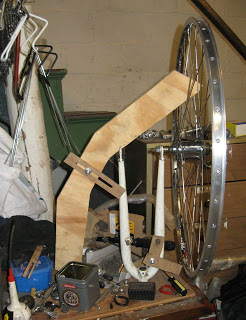Just like everyone else interested in the Wyrd Miniatures/Worldworks Terraclips terrain building sets probably has, I read and heard lots of good reviews about the kits… and then I bought them: one each of the Streets, Sewers, and Buildings kits, and three boxes of clips. This is definitely a high quality, well designed product. However, instead of repeating all the glowing praise I read before I bought them, I’ll list all my picky problems. Hopefully this will help someone to decide whether this is the right toy for them.
My overall summary is: I think these would work great for D&D 4E dungeon crawls, but I don’t think they’ll be very good forMalifaux.
Here’s a 3 foot square of Malifaux terrain built using parts of all three kits. The build took Frank and I 2 hours to complete. We started with a half-assembled build, and spent some time disassembling it but saved some time reusing a few of the buildings and roofs I built earlier.
And here’s the first problem: Terraclips are slow to assemble. I rarely spend this much time setting up terrain, and that’s when I am planning a historical scenario. I’d rather spend my time crafting individual terrain pieces that can be reused quickly, or playing a game.
Because of the long setup time, you need either a lot of free time, or a place where the completed terrain can sit until you use it. Unlike large purpose-built terrain boards and smaller area/element terrain pieces, Terraclips can’t easily be stored assembled.
Many reviews I’ve seen gawk at the huge amount of stuff you get in each box. It’s true: you get a lot of stuff. However, having a lot of stuff doesn’t necessarily mean building a large area of terrain. The kits come with the parts needed to do anything, but not to do everything at the same time. For example, there are enough roof pieces to handle any L-shaped or T-shaped building, but you can build more square one-story buildings than you can add roofs to. If you build taller buildings, they take up less area on the map, so you require more streets and sewers to take up the slack.
We found that we had a huge number of balcony and railing parts left unused (unpunched, even), but we ran out of roofs and walls without doors. Another challenge is using the right ratio of 6″ and 3″ pieces, to ensure that you don’t run out of one before the other.
These parts are also quite fiddly to assemble. Experience would definitely help building things faster and more cleanly, but I don’t expect I’d ever be fast enough to roll up a Malifaux scenario and then build terrain for it as the rules recommend.
The clips all have a bump on one side but not the other (look in the clip’s slot, which tends to put a slight angle in the connection, especially when using I clips. The T and L clips don’t join up the cards in the same orientation at the corner, depending on which direction the clip is used, which can leave you with some less than square buildings if you don’t align all the clips the same way. All these little errors add up over the course of a large build. The few instructions available implore you to make sure everything is lined up properly and fully assembled, but it’s still fiddly.
The remaining issues I have with Terraclips are related to how they will work with Malifaux.
Malifaux didn’t have any comprehensive rules for working with buildings, the last I checked. All terrain pieces were “area” or “element/item” and had an overall effect; they didn’t contain discrete walls, doors, windows, and so on. In previous games using our scratch built buildings and Mordheim buildings, we adopted the Mordheim rules: any obstruction gives you cover, and line of site is WYSIWYG.
WYSIWYG line of site works great… as long as you are able to use terrain to disrupt and limit that line of site without being able to completely hide. In this regard, the terraclips don’t perform well. None of the wall sections have open windows, they only have doorways and arches. These highly enclosed buildings have the effect of breaking the board into small, isolated, easily protected sections. We have yet to see how this plays out in practice.
We also found it difficult to add enough buildings to a flat city street grid, to block the line of site across the board adequately. We were limited by roofs. We might have been able to build a few more buildings taller, but we couldn’t really add more of them. Actually, this is great for my Perdita crew, so I’ll just stop complaining now.
For what they are, the Terraclips do a very good job. These will be great for doing D&D dungeon crawls and encounters inside buildings, and I could even see building a dungeon crawl on the fly if it’s straightforward enough. They even have 1″ squares subtly printed on all surfaces. But I don’t have high hopes for building a wide variety of different terrain boards for a series of Malifaux games.
In the future I’ll be sticking to building more individual terrain elements to place on my Terrainguy mat, but I’ll save these kits to build dungeon crawls, assuming I can ever fit them back in their boxes.




